The Pentacon Six
System
by TRA
Design Variations,
Calculation Dates and Serial Numbers of Carl Zeiss, Jena
lenses for the Pentacon Six
Design
variations
Zeiss lenses in the Praktisix/Pentacon Six mount were produced
during a period of 35 years: from 1956 to 1991. Over this
period of time, various changes were made to the lenses.
Some lenses were re-calculated during that time, but most were not,
so there are two principal differences between most lenses produced
during that period of time:
a) stylistic or “cosmetic” changes
| The very first post-war lenses had a mostly metal-colour
finish, with a black leather band on the focussing ring.
This 80mm Tessar lens in Praktisix / Pentacon Six mount
left the production line on 27th February 1958.
Most Zeiss lenses other than the 1000mm mirror lens had
the same design style, so when changes of styling were
introduced, they were phased in to all other Zeiss
lenses except the mirror lens.
(Meyer-Optik / Görlitz did not follow these style
conventions and mostly produced lenses with a black
finish during the years that the Praktisix and Pentacon
Six were manufactured, though lenses in the early-to-mid
1950s were bright alloy).
When buying any camera with inter-changeable lenses,
bear in mind that the lens may not be the one that was
on the camera when it was new. This Praktisix II
was manufactured between 1964 and 1966, but the Tessar
lens shown here was last produced in the Praktisix mount
in February 1958. It would have been fitted to the
original version of the Praktisix.
The makers of the Praktisix decided that the camera
would sell better if it had the option of a more
prestigious standard lens than the four-element Tessar,
although we should not forget that at the time the first
Hasselblads were also being supplied in many markets
with a Tessar lens. (However, the Meyer-Optik
Primotar continued to be offered as an economical
alternative for a number of years.)
|
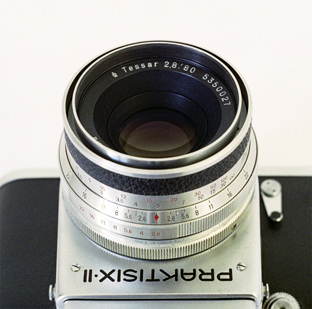
Tessar 1958
|
| For the Praktisix a change of Zeiss lens on offer was
made to the five-element Biometar, which was first
produced in the Praktisix mount on 24th March 1959
(earlier versions having been produced for the Rolleiflex
and other cameras). This had the same optical design
as the 80mm Planar lens that was
being produced by the West German Zeiss factory at about
the same time.
The first 80mm Biometars for the Praktisix had the same
cosmetic style as the Tessar illustrated above – mostly
alloy, with a black leather focussing band.
However, some of the lenses later in the same
production run(!) of 7,000 80mm
Biometar lenses introduced a style change: a plastic
band with bumps on it was used on the focussing ring
instead of the leather band. The lens illustrated
on the right here was part of that first production
run. It rather looks as though the manufacturers
used up their stocks of leather bands before starting to
use the plastic rings with the bumps – or perhaps the
plastic rings were a component that was not ready at the
beginning of the production run, a situation that
regularly occurred in the post-war years in East
Germany.
|
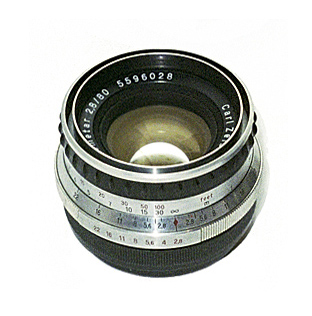
Biometar 1959
|
| Subsequently, the barrel sections with the distance
measurements and the depth-of-field index ring were
produced in black, with white numbering for meters and red
for feet, and the “bumpy ring”, as I call it, was used for
focussing. The aperture selection ring continued to
be plain alloy, with red numbers. The very front
ring, with the thread to accept filters, also now had a
black front edge.
Pentacon Six brochures produced in 1966 and 1967 show
lenses with this finish. However, this particular
lens completed the final stage of manufacture on 17th
December 1964, and it would probably have been
supplied on a late Praktisix IIA.
One 1968 brochure also shows lenses with this finish,
but the lenses must have been taken from earlier
production runs, as the mostly-black lens style with a
leather band on the focussing ring had entered
production in 1965 – see the next section.
This “bumpy ring” was not very reliable. With
rough handling it could easily crack or work loose, so a
return was made to a leather band.
|
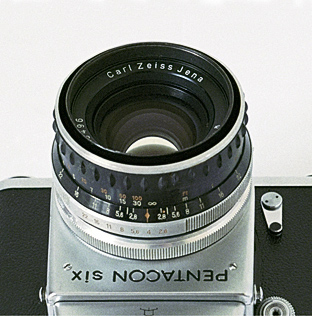
Biometar 1964
|
| The 80mm Biometar illustrated here was completed on 29th
November 1965. It may well have been supplied on
this Praktisix IIA body.
For this lens the aperture index ring, the focussing
ring and the whole of the filter ring were black.
The aperture selection ring was still plain metal with
red numbers.
The next version of the lens – the famous “zebra”
design – was in production by 1967.
|
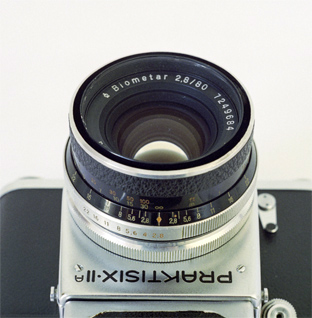
Biometar 1965
|
| The so-called “zebra” lenses had a finish that was
mostly black, but with plain metal stripes and front edge
on the focussing and aperture rings. (This was
approximately 1967-74.) This 80mm Biometar was
completed on 28 September 1971.
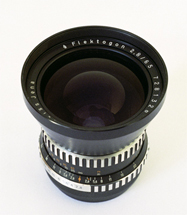 Each time there was a style change,
all the lenses within the range were made to the same
cosmetic style. Each time there was a style change,
all the lenses within the range were made to the same
cosmetic style.
This 65mm Flektogon was completed on 27 May 1967.
However, the changes were gradual (presumably as parts
were used up). See more about this below.
|
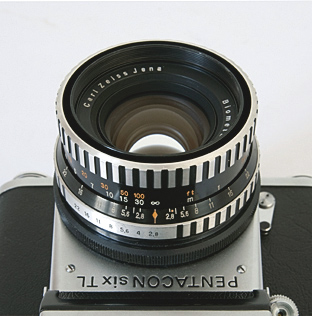
Biometar 1971
|
| After that the lenses were designed all in black, with a
diamond or pyramid-shaped pattern on the focussing ring,
but a bright metal front edge to the focussing ring.
Note that – as with previous versions of the lens – the
feet (red) and metres (white) distance markings continue
to be shown on this lens, which was finished on 19th
July 1978.
|

Biometar 1978
|
| Later, various changes of style of the all-black lenses
were introduced. This is one of the last Biometars
produced. It was completed on 29 September 1989,
about six weeks before the fall of the Berlin Wall, which
led to dramatic economic as well as political changes in
the GDR.
Note the lack of feet markings – export to the U.K. and
the USA had long since been abandoned.
Notice also that the front edge of the focussing ring
is now black.
|
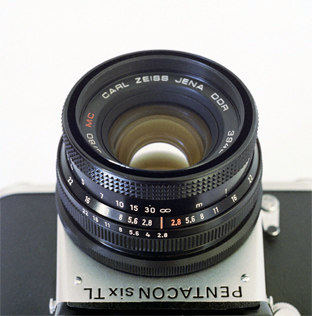
Biometar 1989
|
There was of course also a subsequent version of the 80mm
Biometar, but this was not in any sort of Zeiss design; it had the
design of the Schneider-Kreuznach lenses that were supplied for
the Exakta 66 (1984-2000 version). You can see pictures of
it here.
Note that this is a summary of the main style changes only.
For instance, there were changes of lettering style and size on
the lens name ring, and the actual wording used, depending on the
intended market.
There were also other changes. For instance, on the 180mm
and 300mm Sonnars, the stop-down lever was replaced with a
“switch” that could be moved between open-aperture and
stopped-down positions, and the barrel of the 300mm Sonnar was
re-designed to make it slightly smaller and lighter.
As a further example, here are two 120mm Biometar
lenses.
The one on the left has a number in the ten millions and
was completed on 31st October 1978.
The one on the right has a five-digit serial number in the
ten thousands and was completed on 27th April 1990.
It is one of the last lenses manufactured by Carl Zeiss
Jena before all the changes that occurred in 1990 and
subsequently.
There are two main differences between the two lenses:
1) As with the 80mm Biometars above, the the front
edge of the focussing ring on the 1978 lens has a shiny
polished metal finish, while on the 1990 lens this edge
is black.
2) If you look carefully, you will just be able to
see that the 1978 lens has distances marked in metres
(in white) and in feet (in red), while the 1990 lens
only has distances in meters.
Those who look at every detail will observe that the
placing of the letters “MC” is different on the two
lenses. In fact, the lettering on the front ring
of the newer lens is also larger and less spaced-out.
The two lenses have projected images of the window
opposite them onto the background (naturally,
upside-down!).
|
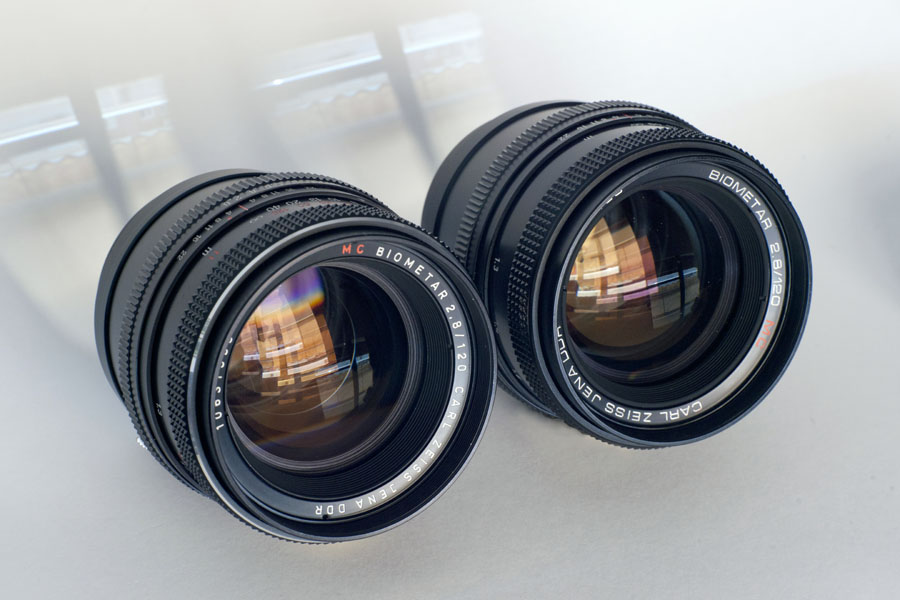 [2_120bms.jpg]
[2_120bms.jpg]
|
| Phasing-in of style changes
As indicated above, constant shortages were a factor in
life in post-war Germany (and in East Germany right up
to the end, in 1989!). Components, once
manufactured, had to be used, and this, of course led to
the gradual introduction of changes
across the lens range. This is a source of
multiple small variations in the details of the lenses
that were produced. (This is fascinating – or
frustrating! – for lens collectors!)
This can be seen in the illustrations of equipment in
much of the manufacturer’s literature. The image
to the right is taken from a 1964 Praktisix II
brochure. In it, the 80mm Biometar and the 65mm
Flektogon have the plain alloy finish with the leather
focussing band (as in the first image above), while the
50mm Flektogon, the 120mm Biometar and the 180mm Sonnar
have black rings for the focussing and aperture
markings, with the bumpy black plastic focussing ring
and light alloy aperture rings (as in the third image
above).
The lens on the far right is the 300mm f/4.5 Tele-Megor
from Meyer-Optik, who did not follow the Zeiss style
conventions.
The 1000mm Zeiss mirror lens almost never followed the
Zeiss style used with other lenses. It was
generally a pale grey, sometimes with a hint of cream or
green. In this image, it has a light shade of
blue, which presumably reproduces correctly the colour
of the original lens photographed. Only in the
very last years was an all-black version available.
Note that at the time that this brochure was prepared,
three East German lenses that subsequently became part
of the standard offering for the Pentacon Six had not
yet started production: the 300mm f/4 Zeiss Sonnar, the
500mm f/5.6 Meyer Orestegor and the 300mm f/4 Meyer
Orestegor.
This particular brochure was designed for the United
States, where there were at the time court cases,
initiated by West German Zeiss, to try to prevent Carl
Zeiss Jena from using the Zeiss name and other Zeiss
lens names such as “Biometar” and “Sonnar”. It is
for this reason that the manufacturer is merely referred
to as “Jena”, and the lenses have the names “Bm” and
“S”, respectively. “Flektogon” had never been used
by West German Zeiss, who used the name “Distagon” for
its wide-angle lenses, which is why the Flektogon name
does appear in this brochure.
You can read more about these legal desputes, and how
they were resolved, here.
|
|
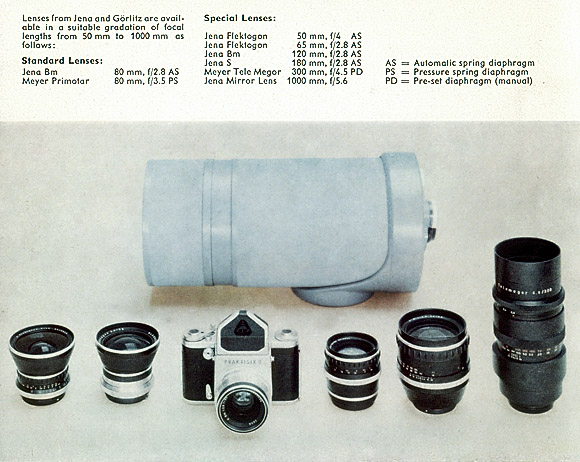
A page from a 1964 Praktisix II brochure/catalogue
|
b)
Single coating or multi-coating
Starting in 1976, Carl Zeiss gradually introduced
multi-coating for all its lenses. This is easy to
identify, as multi-coated lenses are marked “MC”. In
the early years of the change, these letters were in red
paint, but from about 1980 onwards, the letters “MC” were
usually in white paint. If you see two equivalent lenses,
but one is single-coated and the other is multi-coated, I
would of course recommend the multi-coated lens, which
will be newer.
|
|
What do multi-coated
lenses look like?
Some lens
produced in about 1976 were multi-coated, but did not
yet have the letters “MC” or the words “MULTI COATING”
engraved on the name ring. A
visitor to this website has therefore asked me how to
identify whether or not a lens is multi-coated.
Simply put, if one can hold a lens at such an angle that
reflections can be seen on the elements, it is generally
possible to be reasonably sure whether or not the lens is
multi-coated. In particular, multi-coated lenses
general display reflections of various colours.
However, some warnings must be given:
- over time, manufacturers sometimes change the details
of the multi-coating, which can results in reflections
of different colours from those with other lens that may
be otherwise identical;
- the colours of the reflections depend on the ambient
light
- the colours of the reflections depend on the angle at
which the lens is viewed.
With these provisos, I show here a 180mm MC Sonnar that
left the production line in December 1983.
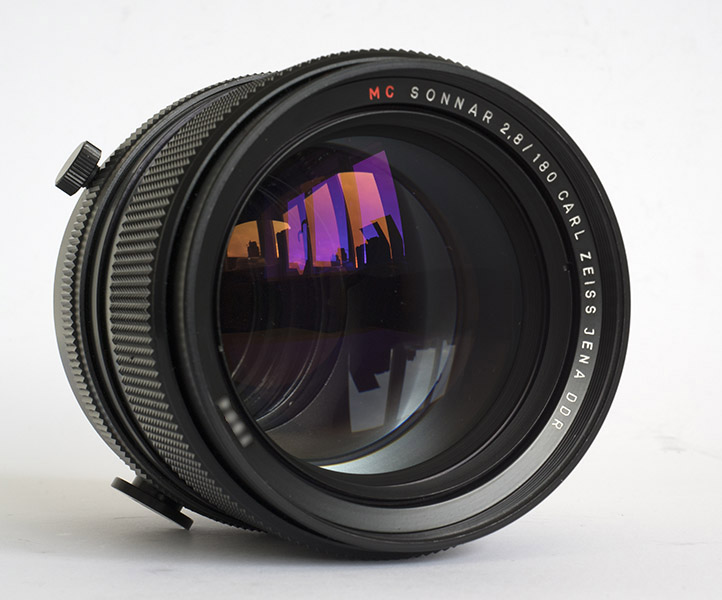
[MC180S_01jpg]
|
|
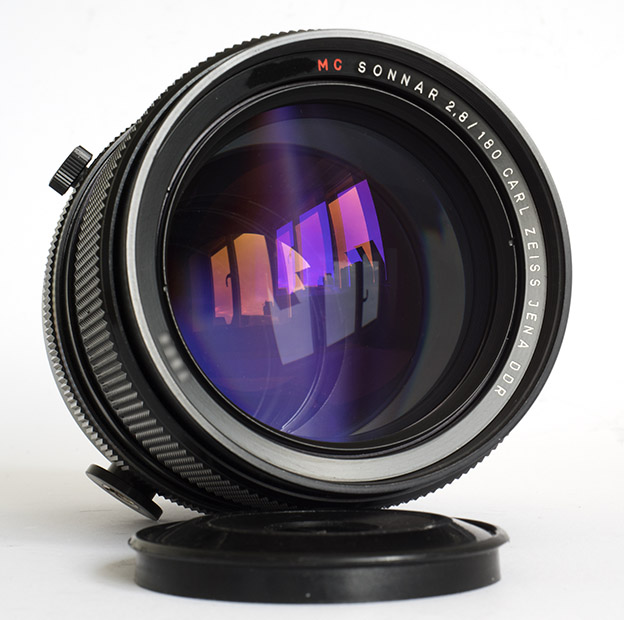
Not the differences in the reflections as we change
the angle of view.
[MC180S_02.jpg]
|
Two multi-coated 120mm Biometars can also be seen above
(photographed in quite different ambient light from this
180mm Sonnar).
|
|
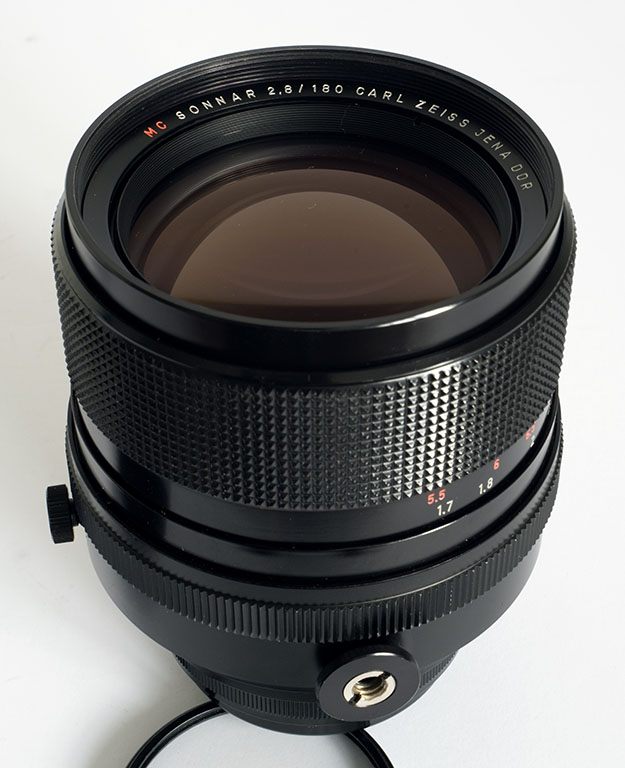
From a different angle, the reflections from the same lens
are quite different.
[MC180S_03.jpg]
|
c) Optical Re-calculation of
lenses
Various lenses with the Praktisix/Pentacon Six mount were
optically re-calculated over the period of many decades during
which they were produced. One example is the 80mm
Biometar. The original version of this lens in the
Praktisix/Pentacon Six mount was calculated on 5th June 1956,
although the first batch of this lens in what was at the time
called the Praktisix mount was not produced until 24th March
1959. Over the following 30 years, almost all of the 80mm
Biometars that were produced used the 1956 calculation.
However, on 31st October 1979 the 80mm Biometar was
re-calculated. Nevertheless, even after this date most of
the 80mm Biometars produced were to the original
calculation. Ten years later, on 29th March 1989, just one
batch of 6,000 80mm Biometars was produced using the new
calculation. The serial numbers of that batch are 42,001 –
48,000
Here is a summary of the design dates of Carl Zeiss lenses in the
Praktisix/Pentacon Six mount. However, as will be obvious
from the preceding paragraph, sometimes even after a new design
was calculated, the lens continued to be manufactured to the
previous design, and sometimes even after batches made to the new
design were produced, some subsequent batches were made to the
previous optical design.
|
Lens
|
Optical Calculation date(s) |
| 50mm Flektogon |
25 March 1958
27 May 1966 |
| 65mm Flektogon |
6 January 1950 |
| 80mm Biometar |
5 June 1956
31 October 1979 |
| 80mm Tessar (1) |
7 July 1950 |
| 120mm Biometar |
30 July 1956 |
| 180mm Sonnar (2) |
14 February 1959
4 July 1966 |
| 300mm Sonnar |
19 August 1963
11 July 1974 |
(1) The Tessar had of course
existed for decades before a version was calculated for use with
the German post-war medium format cameras.
(2) It is of course
well-known that this lens was first calculated and designed for
the 1936 Berlin Olympics, where it was used on a 35mm Contax
rangefinder camera. However, the first version that was
manufactured in the Praktisix/Pentacon Six mount was the
February 1959 re-calculation.
Reasons for re-calculating lenses
It should be borne in mind that there could be various motives
behind a re-calculation, and one must not automatically assume
that a newer calculation must be optically better; the
purpose of the re-calculation might be to reduce weight,
as in the case of the 300mm Sonnar.
Changes in other requirements could also lead to
design changes. Thus, for example, the first design of the
two Sonnars for the Praktisix/Pentacon Six incorporated automatic
micro-adjustment of the diaphragm diameter as one focussed closer,
to compensate for the slight reduction in light transmission to
the film as the barrel length was increased by focussing
closer. (As one focussed closer, the diaphragm opened
progressively.) Two factors led to the removal of this
feature when the lenses were re-designed:
- the improved exposure latitude of colour film
- the provision of through-the-lens metering on the Pentacon
Six, with the introduction of the metering prism.
Other motives might include reducing manufacturing costs
or making manufacture, assembly or servicing easier.
Optically, all of the Carl Zeiss lenses are excellent. The
mechanical condition depends on whether the lens has been looked
after or badly-treated by a previous owner – for instance, if it
has been dropped or taken apart by someone who does not understand
lenses.
Serial numbers
| Fortunately, it is possible with the help of the
serial number to date most of the lenses that Carl
Zeiss, Jena produced and there is a book that gives
detailed information on the date of design and
manufacture of Carl Zeiss lenses, based on the serial
number. This book is Dr Hartmut Thiele’s
“Fabrikationsbuch Photooptik II Carl Zeiss Jena”, which
lists most Carl Zeiss Jena lenses manufactured between
1927 and 1991. I recommend this book to anyone who
wants to go into the details of Carl Zeiss Jena serial
numbers. The book costs about 50 Euros.
Batches of serial numbers were apparently assigned to
the production department in Carl Zeiss, Jena in
sequence order. i.e., if the last lens in the
previous batch of lenses had the number 8,000,000, the
first lens in the next batch would be given the number
8,000,001. However, sometimes the production
department did not make the batches in the same order
as the serial-number blocks that had been assigned to
them. Thus, for example, a batch of 5,000 80mm
Biometars was assigned the serial-number block
10,890,988 – 10,895,987 and this batch was finished on
2nd September 1980. The previous block
of 5,000 serial numbers (10,885,988 – 10,890,987) had
also been assigned to a batch of 80mm Biometars, but
this batch was not completed until six months
later, on 28th February 1981. However, in
spite of details of this nature, serial numbers are a
good guide to the age of a lens.
In the example above, I have added commas here, to
make the numbers easier to read, but no commas, full
stops or spaces were used when the serial number was
engraved on the lens, unlike the practice of
Schneider-Kreuznach, who put spaces where I have put
commas.
By mid 1980, Carl Zeiss had reached the serial number
10,982,372 (nearly 11 million). It then decided
to start the serial numbers anew, apparently beginning
at 1,0001 (although there are very small numbers of
lenses produced in the 1980’s with lower numbers than
this). So most lenses made between about mid
1980 and 1991 had four or five-digit serial numbers
and are therefore the newest lenses. (You can
see from the example given above that some of the
lenses with serial numbers in the ten millions were in
fact not completed until early in 1981.)
|
|
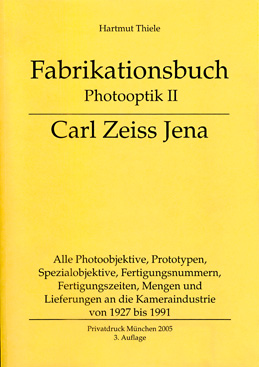
Hartmut Thiele’s book on Carl Zeiss
Jena lenses
|
A wide range of Carl Zeiss Jena lenses in Praktisix/Pentacon Six
mount are illustrated and tested in the Lens Test section of this
website. To go to the lens test section, click here.
To see some information on camera body variations and dates, see
here.
To go on to the next lens data section, click below.
How the country of origin of East German
lenses was specified
To go back to the beginning of the Lens Data section, click below
and then choose the range of lenses that you want to read about.
Back to beginning of the Lens Data section
Home
© TRA January 2010.
Latest revision: June 2019




 Each time there was a style change,
all the lenses within the range were made to the same
cosmetic style.
Each time there was a style change,
all the lenses within the range were made to the same
cosmetic style. 







